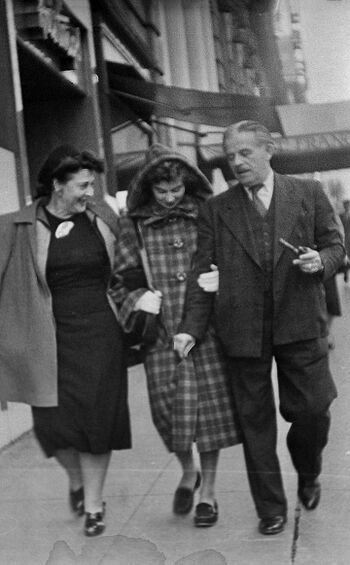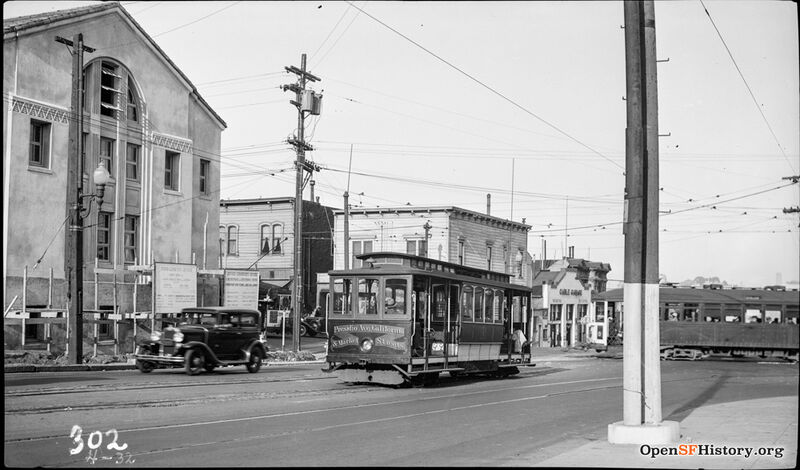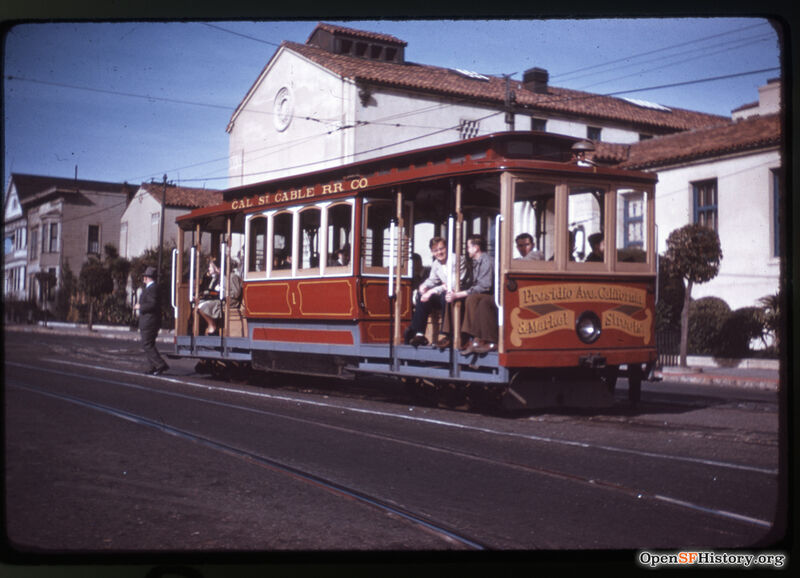Jewish Community Center
Historical Essay
by David Kupfer
April 1932 view northeast across California Street to Jewish Community Center under construction.
Photo: OpenSFHistory wnp14.4668
Ninety years ago last month, on Dec. 11, 1932, it was a historically chilly day in San Francisco. The city recorded its coldest temperature ever, 27 degrees, and it was actually snowing as the cornerstone for the Jewish Community Center was laid at 3200 California Street.
Presiding was no less than Gov. James Rolph Jr., Mayor Angelo Rossi and local Jewish leader Lloyd W. Dinkelspiel, who, along with my grandfather, Louis H. Blumenthal, founded what was then called the San Francisco JCC. Blumenthal was executive director from 1924 until his death in 1959.
For nine decades, the JCCSF has been a most significant cultural, social, and spiritual community institution, for both immigrants and Jews alike, meeting changing needs with the changing times, and standing as a monument to the strength and pride of the San Francisco Jewish community.
Formally incorporated in 1930, the JCCSF traces its roots back to 1874 and the founding of the Young Men's Hebrew Association The JCC reflected national and local efforts to facilitate work among Jewish social, athletic, cultural and charitable organizations by gathering them all under one roof.
In a 1954 article in the Jewish Community Bulletin, commemorating the JCCSF’s 77th anniversary, Sally Mirliss Blake wrote, “The Center today is a polyglot mixture of people, activities, services and programing. Members come from every major city in the United States and many other countries. Their vocations are equally varied; from stenographers and typists, to doctors and dentists, longshoremen and pawnbrokers. Activities are so extensive it is difficult to list them: gym and swim, social, hobby groups, the arts, Jewish life, children's programs.
“From ages seven to 70, the Center caters to an immense variety of interests and needs and provides a wide variety of unique services, such as free counseling in personal and family problems, a summer home camp for children and a meeting place for some 70 communal groups. To those unable to pay, the Center authorizes free memberships, while activities are always open to members of the Armed Forces free of charge.”
The building was a 61,750-square-foot, two-story unique structure constructed of materials including Spanish clay tile roofing, stucco exterior finishes, and painted wood windows and doors. Significant interior building elements included a lobby skylight, interior patio with ornamental metal staircase, a tiled fountain and exposed wood trusses in the gymnasium.
The design was the work of the well-known S.F. architect Arthur Brown Jr. and the associated firm of Hyman and Appleton. Designed in a Mediterranean style with art-deco details, it was an eclectic design of the early 20th century, and its style suggested the process of assimilation of European Jewish immigrants — and their efforts to secularize services and recreation to benefit the broader community.

My grandparents Emma Loewy and Louis Blumenthal, and my mother Marcia Blumenthal Kupfer in the late 1940's on the streets of San Francisco.
Photo: courtesy of author
In 1924, my grandfather Louis Blumenthal was hired as Executive Director of the JCCSF. Five months later, my step-grandmother Emma Loewy was hired as Associate Director, and a decade later, they were married.
In its first year, membership grew to 1,000 and more than 45,000 people used the center's facilities and programs, and 25 clubs and 35 communal organizations used its meeting rooms. By 1936, one out of every 10 Jews in the S.F. area was a member.
In the 1930s, Jewish groups increasingly used the JCC as a town hall, and courses were offered on everything from the U.S. labor movement to foreign languages, knitting, ballroom dancing, painting and women’s calisthenics. Book exhibits, art shows, concerts and lectures took place as well.
World War II saw the JCC increasingly involved in social work activities. Refugees from Germany, Austria, Poland, Spain and Czechoslovakia began arriving in 1938. The center provided them free membership, as well as classes in English, Americanization and citizenship. Civilian defense, Red Cross and physical fitness courses were given; Civilian Defense members received free memberships. Later, childcare was provided for mothers working in war industries. In the late 1940s, summer "home-camps" were created for children within the fences of an adjacent vacant lot.
November 3, 1947. California Street cable car #1 chugging along in front of the Jewish Community Center.
Photo: OpenSFHistory.org wnp35.0309
Radio personality and fourth-generation San Franciscan John Rothmann told me recently that “The first Holocaust commemorations in San Francisco and the anniversary of the birth of Israel were held at the JCCSF." He also mentioned of its kosher kitchen and its Kosher Nutrition Project.
“As Jews arrived from the Soviet Union,” he added, “they gathered for programs at the JCC. The Zionist Organization of America held its major programs” there. He also noted that the JCC’s relationship with the Booker T. Washington community center was a special one, and that “Jews and Black kids swam together in the JCC pool when I was a kid in the 1950s.” He said San Francisco African American leaders such as Granville Jackson and Terry Francois were often participants at the JCC.
Marcia Blumenthal Kupfer at summer camp, apx. 1940.
Photo: courtesy of author
Beyond their JCC SF work, my grandparents founded and directed in the 1920s-30s, Camp Kelowa and Camp Singing Trail, located near Yosemite at Huntington Lake in the High Sierras, Summer camps for Jewish girls and boys. After WW 2 these two camps merged and became Camp Tawonga.
<iframe src="https://archive.org/embed/cbm_00002" width="640" height="480" frameborder="0" webkitallowfullscreen="true" mozallowfullscreen="true" allowfullscreen></iframe>
This film was produced by Louis and Emma Blumenthal to provide a glimpse of life at both Camp Kelowa and Camp Singing Trail in 1936.
Emma Blumenthal spent 39 years as associate director of the JCC. Both Louis and Emma were engaged with issues relating to youth, camping, child health, and social work. Louis was the author of multiple books on group work and camping and served on national and regional camping organizations.
My unsung grandparents, Louis and Emma Loewy Blumenthal played central roles in Jewish communal life in San Francisco during the middle of the 20th century. This is my tribute to them.



